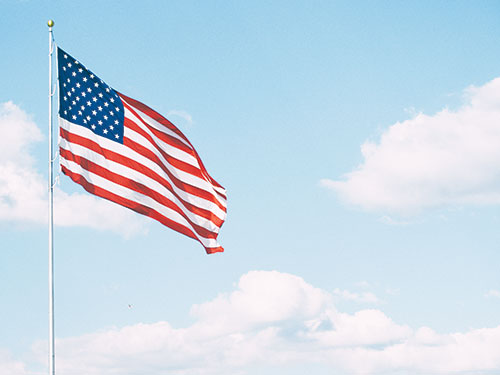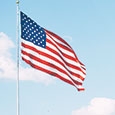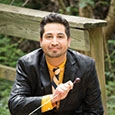
“Intended as a gesture from an inhabitant of the old world to those of the new.”
–Gordon Jacob
Gordon Jacob’s Flag of Stars, Salute to America (1953) is a significant work written for band that lives between notoriety and obscurity and often seems overlooked in concert programs and recording projects past and present. The purpose of this article is to shed light on some interesting new perspectives about the distinguished history of the piece and perhaps encourage more future performances and recordings.
Flag of Stars is part of an important chapter in the history of the band repertoire. Gordon Jacob wrote it between 1953 and 1954 as part of a multiyear commissioning project that encouraged prominent composers to write original band works. The project was sponsored by the Pi Kappa Omicron Band Fraternity at Louisville University, now the University of Louisville. A fascinating article written by J. Michael Raley in The Journal of Band Research (Spring 2017) entitled Ernest E. Lyon and The Pi Kappa Omicron Fraternity Band Music Commissioning Project at the University of Louisville (1949-1958) explores the significance of this commissioning project.
Raley writes in the conclusion of his article that “four commissions were eventually published (Riegger’s Prelude and Fugue for Band, Persichetti’s Psalm for Band, Jacob’s Flag of Stars and Schuman’s Chester Overture) Today the latter three rank among the highest-rated works in the concert band repertoire, and we have them thanks to Ernest. E. Lyon and The Pi Kappa Omicron Fraternity.”
According to Raley, Flag of Stars is “ranked among the highest-rated works” alongside Persichetti Psalm for Band and Shuman’s Chester Overture, however the reality is that Flag of Stars does not share the same recognition. Comparing the number of performances and recordings of Chester Overture and Psalm with those of Flag of Stars in the last 20 years shows that the latter is vastly overlooked. Flag of Stars is not listed as a top or selected work for band in various important published lists of selected wind literature such as Frank Battisti’s The Winds of Change or Chad Nicholson’s A Guide to the Top 100 Works in Grades IV, V, VI. It is out of print in the United States. There are also not many professional recordings of the piece. There is one recording on Mark Custom Records by the J.J Pearce High School Band from Richardson, Texas from the 1990s, and the only commercial recording of the piece by a collegiate group was done by Eugene Corporon and the North Texas Wind Symphony. Therefore, it is possible that if we do not pay attention to this important piece it may be forgotten soon.
Outside of the commissioning project at the University of Louisville, this Symphonic Overture for Band, also shares a decade with some of the most celebrated and performed original works for band. It is plausible this cleverly crafted masterpiece has been overshadowed by some of these more well-known works written for band during the same decade such as the unequivocally famous Hindemith Symphony in B flat (1951), Howard Hanson’s Chorale and Alleluia (1954), Morton Gould’s West Point Symphony (1952) or Persichetti’s Pageant (1953) and Symphony No. 6 for Band Op. 69 (1956). However, its sophistication and compositional merit are up to par with any of these great masterpieces from the 1950s.
There are two letters written by Ernest E. Lyon and Gordon Jacob found at the archives of the University of Louisville Music Library that discuss the reception of the work in 1954. The letter from Lyon to Jacob (below) indicates how delighted they were at the University with the fine composition and is full of praise for the composer who was of the same stature as Vincent Persichetti or Paul Hindemith, among others. It is also a testament to the quality and reception of the composition in 1953. Lyon says that many college band directors looked forward to this new work for band and believed the composition would have a “fine future for performances among first grade bands” – a predicted future that looks dim in today’s concert programs if we do not program and record it more often.

The opening fanfare of Flag of Stars. Both the score and the letters are courtesy of the Dwight Anderson Memorial Music Library at the University of Louisville
April 6, 1954
Dear Dr. Jacob:
I want to tell you how delighted we are with the “Flag of Stars” Overture. Having known you through your orchestral technique book, your Original Suite, your Music for a Festival, William Byrd Suite, and your reputation in general I have looked forward with great pleasure to receiving the overture. We are by no means disappointed in any way and predict that Flag of Stars will have a fine future for performance among first grade bands.
I suppose that the members of the Fraternity have told you that the first performance of your work will be on Tuesday evening,May 11, by the University of Louisville Concert Band. I should add also that a great many college band directors around the country already know that the Fraternity here has commissioned the Overture and are looking forward with pleasure to its being made available. I hope that it will be published at the earliest possible opportunity. I have checked the score rather carefully and am now proof-reading for the final time the parts I have corrected as I found them, but there are a few things which seem to me to be “slips of the pen.”
Lyon’s letter goes on to ask specific questions he had about the original manuscript. All his corrections were approved by Jacob himself in the r esponse to this letter, and the piece was published in 1956 by Boosey & Hawkes with Lyon’s revisions. Lyon’s meticulous revisions to Jacob’s “slips of the pen” in the manuscript contributed to a reliable and excellent publication of the piece. Lyon goes on to write:
Incidentally, I wonder if you know that your William Byrd Suite and your Original Suite for Band are both out of print, or at least were the last five or six times I checked on Boosey and Hawkes to see if they were available. I have played both pieces and have a set of parts to the Original Suite but I always have to borrow the William Byrd when I want to perform it.
Ernest E. Lyon, Director
Department of Bands
Gordon Jacob responded to Ernest Lyon’s letter on April 20th, 1954, and part of this letter has been published in the program notes on the score by Boosey & Hawkes. However, I will provide the entire letter to put Jacob’s words into better context and discuss two important elements in the letter that have been left out in the score by the publishers.
Dear Mr. Lyon,
Thank you very much for your letter of April 6th. I have not a copy of the score of “Flag of Stars” but I have no doubt that the mistakes you found in it were slips of the pen and I agree to your corrections of them which I hope you will insert in the score.
I am very pleased to hear that you are pleased with the work and I wish very much that I could be with you on May 11th for the first performance. I was extremely flattered by being commissioned to write this work and I took it as an opportunity to make a humble contribution to the friendship between our two nations upon which the future welfare of the world depends in great measure.
It is difficult for me to write a program note, but I hope that the quotations from Walt Whitman will always be given on programs when the work is performed. I enclose a few notes which might be useful.
The overture was written during the end of 1953 and the beginning of 1954 and is intended as a gesture from an inhabitant of the old world to those of the new. The introductory fanfare and the slow section which follows it recalls the sacrifices made by your county during both world wars and more recently in Korea in the struggle with dark forces of destruction. The allegro is prompted by thoughts of the energy, vitality and cheerfulness of the American people – young, enthusiastic, and full of faith in their destiny. The second subject in 34 time might perhaps suggest a sort of national song and right at the end there is a brief quotation from the “Star-spangled banner”. But apart from any extra musical meaning the work is constructed solidly on classical formal lines though its musical language is that of the 20th century. (but not of the extreme type) . . .
No doubt the writer of the notes will be able to amplify the above with the aid of the score. I expect you have enough biographical details to fill it out if necessary. If it were possible to let me have a recording of the tape recording I shall be most grateful but this may be asking too much. I am full of admiration for the fraternity and for what they are doing in the cause of music.
Yours sincerely,
Gordon Jacob
Boosey & Hawkes published part of this letter on the first page of the score as well as the Walt Whitman poem per Jacob’s wishes. However, there are two important things that the publishers left out. First, Jacob writes that this work is also to honor the veterans from the “more recent” Korean War. This is an important detail that is missing in the published score and adds on a greater significance to the work. Jacob’s decision to include the veterans of the Korean War in the dedication suggests that he was open to honoring more than just World War I and World War II veterans. Therefore, as time goes on this piece should not be forgotten and should be thought of as a continuing tribute to veterans from all wars that followed the 1950s.
The other detail left out from the original letter is the ellipsis. Jacob wrote that this symphonic overture is “constructed solidly on classical formal lines” and that it has the “twentieth-century musical language. (but not the extreme type) . . .” Perhaps Jacob used an ellipsis in his letter to Lyon to suggest he had an opinion about “extreme twentieth-century techniques” practiced by some of his contemporaries like Varese or Messiaen but did not want to elaborate. There is no way to know for sure if this speculation is true, but I believe Jacob’s use of an ellipsis in the letter had a meaning behind it. Otherwise, he would have not written it in the letter.
Lyon was full of praise for Flag of Stars and shared his view with important people. In a letter from 1954, Edwin Franko Goldman wrote to Lyon “I am glad the new piece by Gordon Jacob (Flag of Stars) seems to be so interesting and hope to see it sometime. I suppose it will be published in the near future.”
A thorough play-by-play analysis of the piece would be interesting and beneficial for longevity, but it is not necessary to appreciate its compositional merit. The overall architecture of the piece and careful construction of its themes are enough to appreciate it as a serious and carefully crafted work. The piece is in sonata form with an exposition that starts at letter C, a development that starts at letter J and a recapitulation at letter O. It has a two-part retransition that precedes the recapitulation. It also has a four-part introduction and a wonderful coda beginning at letter V that brings back thematic material presented in the introduction and features a brief but recognizable quote from the Star-Spangled Banner.
The first theme of the exposition is cleverly transformed from 5/8 to 3/4 at the Piu Mosso to conclude the work. The first and second themes in the exposition are also important to discuss because they reflect the “solid classical formal lines” Jacob talks about in his letter to Lyon. The first theme (m. 43-70) is in ternary form A B A’, with the A section in sentence form (m. 43-58) and the B (m. 59-66) section in a 2+2+4 small ternary. The A’ section (m. 67-70) is the basic idea of the previous A section’s sentence form but without its repetitions in continuation. The second theme at letter E is in sentence form with a two-bar basic idea presented and repeated almost identically, followed by a four-bar continuation that includes some clever articulation choices for the flutes and clarinets. The form of the themes and architecture undeniably reflect the “solid classical lines” Jacob mentions but the unusual rhythmic choices in an unconventional 5/8 time signature reflect subtly the 20th century spirit without any extremes.
The grandiose trumpet fanfare at the beginning of the piece is part of a very important historical timeline. Flag of Stars was written at the end of 1953 and the beginning of 1954 immediately following the pinnacle of Gordon Jacob’s career as a composer. In June of 1953, Queen Elizabeth II was crowned Queen of England and Gordon Jacob wrote the fanfare that preceded God Save the Queen for the recessional at Westminster Abbey. The coronation of the Queen of England was one of the first television broadcasts to reach millions of people around the world and Jacob’s brass fanfare resounded past the halls of Westminster into the homes of millions of spectators all over the world. It is hard to imagine a more important setting for a composer to premiere a piece of music than the coronation of The Queen of England. Therefore, it is no surprise that as he began to work on Flag of Stars just a couple of months later, he chose to begin the piece with a triumphant trumpet fanfare that perhaps took some inspiration from the coronation fanfare.
It is also important to emphasize that Flag of Stars is a heartwarming salute to America and its veterans by a non-American prolific composer and this also makes it stand out among the repertoire of the time. There was notable nationalistic band music written by composers of the time that celebrated America, such as Robert Russell Bennett’s Suite of Old American Dances (1949) only four years earlier or Joseph Wilcox Jenkins’s American Overture for Band (1959) six years later, but there is not another piece by a world-renowned non-American composer in the 1950s that celebrates America in such a programmatic way.
Luckily, Flag of Stars is still found in the prescribed music lists of Florida, Texas, Arizona, Indiana, and Kansas, among others, which gives hope of more frequent performances. High school and college conductors with strong bands should not shy away from this piece. It is a challenging work, but its rich educational value makes it worthwhile. Once you have programed Flag of Stars, a great resource will be Kenneth Kohlenberg’s contribution to the Teacher’s Resource Guide of the series Teaching Through Performance in Band, Volume 7. In this article, Kohlenberg discusses common performance problems and offers advice and solutions. Apart from Kohlenberg’s article, there is no other literature centered on this piece until this publication. It will be up to the 21st century conductors to dig deeper and keep this excellent piece alive. Most importantly, we should remember Flag of Stars as a significant work for band that helped pave the way for equal or greater original band music after the 1950s and into the rest of the 20th century to present times.
Bibliography
Chronicles. North Texas Wind Symphony conducted by Eugene M. Corporon (GIA WindWorks Series, 2009, CD).
“Ernest E. Lyon and the Pi Kappa Omicron Fraternity Band Music Commissioning Project at the University of Louisville (1949-1958)” by Michael J. Raley (The Journal of Band Research 52, no. 2, Fall 2017: 40-92).
Ernest E. Lyon to Gordon Jacob, April 6, 1954. University of Louisville (Kentucky) Music Library Archives.
Great Music for Wind Band: A Guide to the Top 100 Works in Grades IV, V, VI by Chad Nicholson (Meredith Music Publications, 2009).
The J.J. Pearce High School Bands Highlights 1994-95: Featuring the Music of Sousa, Ives, Copland, and Corigliano (Mark Custom Recording Service, 1995, CD).
Jacob Fanfare and The National Anthem [HD] (Coronation of Elizabeth II, 1953) (www.youtube. com/watch?v=avTIcdWy3AE).
Jacob Gordon to Ernest E. Lyon, April 20, 1954. University of Louisville (Kentucky) Music Library Archives.
Winds of Change II: The New Millennium: A Chronicle of the Continuing Evolution of the Contemporary American Wind Band/Ensemble by Frank L. Battisti (Meredith Music Publications, 2012).






